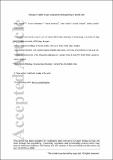Changes in stable isotope compositions during fasting in phocid seals
Abstract
Rationale: The grey seal, Halichoerus grypus (GS), and the northern elephant seal, Mirounga angustirostris (NES), come ashore for reproduction. This period involves intense physiological processes such as lactation in females and a developmental post‐weaning fast in juveniles. Previous studies have shown that δ13C and δ15N values are affected by starvation, but the precise effects of fasting associated to lactation and post‐weaning fast in seals remain poorly understood. Methods: To examine the effect of lactation and post‐weaning fast on stable isotope ratios in GS and NES, blood and hair were sampled from twenty‐one GS mother‐pup pairs on the Isle of May and on twenty‐two weaned NES pups at Año Nuevo State Reserve during their respective breeding seasons. Milk samples were also collected from GS mothers. Stable isotope measurements were performed with an isotope ratio mass spectrometer coupled to an N‐C elemental analyser. Results: Changes in stable isotope ratios in blood components during fasting were similar and weak between GS and NES mothers especially in blood cells (GS: Δ15N = 0.05‰, Δ13C = 0.02‰; NES: Δ15N = 0.1‰, Δ13C = 0.1‰). GS showed a 15N discrimination factor between maternal and pup blood cells and milk, but not for 13C. The strongest relationship between the isotopic compositions of the mother and the pup was observed in the blood cells. Conclusion: Isotopic consequences of lactation, fasting, and growth seem limited in NES and GS, especially in medium‐term integrator tissues of feeding activity such as blood cells. Stable isotope ratios in the blood of pups and mothers are correlated. We observed a subtle mother‐to‐pup fractionation factor. Our results suggest that pup blood cells are mostly relevant for exploring the ecology of female seals.
Citation
Habran , S , Damseaux , F , Pomeroy , P , Debier , C , Crocker , D , Lepoint , G & Das , K 2019 , ' Changes in stable isotope compositions during fasting in phocid seals ' , Rapid Communications in Mass Spectrometry , vol. 33 , no. 2 , pp. 176-184 . https://doi.org/10.1002/rcm.8308
Publication
Rapid Communications in Mass Spectrometry
Status
Peer reviewed
DOI
10.1002/rcm.8308ISSN
0951-4198Type
Journal article
Description
This study was supported by NSF grant #0213095 and by FRFC grant #2.4502.07 (F.R.S.-FNRS).Collections
Items in the St Andrews Research Repository are protected by copyright, with all rights reserved, unless otherwise indicated.

